Automation of the Edge Deburring Process and Analysis of the Impact of Selected Parameters on Forces and Moments Induced during the Process
Abstract
:1. Introduction
2. Problem Definition
- Lack of repeatability of the brushing process;
- Lack of control of forces and moments occurring during the process (lack of objectivity), which prevents any work related to the optimization of tool wear;
- Progressive fatigue of operators during the processing of subsequent pieces;
- Costs of using appropriate individual and collective protective equipment, such as earmuffs and protective sleeves.
3. Solution—Test Stand
3.1. Test Stand
- ABB IRB 2400 industrial robot with ABB IRC5 controller and Force Control system;
- An industrial grinder with a control system that allows one to change the rotational speed of the tool;
- Keyence LJ-V7060 laser profilometer.
3.2. Identification of Key Process Parameters
4. Tests
5. Discussion
- The deburring operation performed on built test stand was performed correctly—based on the observed work-piece condition, burrs were removed successfully—additionally, we created a histogram for the edge radius that confirms that the process is well centered;
- The preparation of an automated stand eliminates a lot of challenges related to human factor, process stability and repeatability, and allows us to eliminate the process of operator fatigue;
- Doubling the rotational speed of the brush results in a linear increase in torque. The obtained results confirm that the above relation is correct for different rotational speeds;
- Compared to manual processing, the operator (locksmith) was not able to work within the range of rotational speed tested. This is directly related to the physical endurance of a human, and directly translates into much faster wear of the brush in a manual process. In connection with these observations, it is important to introduce an industrial manipulator to the process in order to reduce tool wear;
- The increase in the engagement of the detail in the disc brush leads to a non-linear increase in torque. The observed effect is much smaller at higher rotational speeds;
- During the tests, tools that were not brand new were also used. Based on the tests carried out, it was observed that for the new disc, the measured moment during brushing was about 20% higher;
- During all the tests carried out, burr removal was recorded in a way that meets the design requirements.
6. Conclusions
Author Contributions
Funding
Institutional Review Board Statement
Informed Consent Statement
Data Availability Statement
Conflicts of Interest
References
- Hashimura, M.; Hassamontr, J.; Dornfeld, D.A. Effect of in-plane exit angle and rake angles on burr height and thickness in face milling operation. J. Manuf. Sci. Eng. 1999, 121, 13–19. [Google Scholar] [CrossRef]
- Mathai, G.; Melkote, S. Effect of process parameters on the rate of abrasive assisted brush deburring of microgrooves. Int. J. Mach. Tools Manuf. 2012, 57, 46–54. [Google Scholar] [CrossRef]
- Alagan, N.T.; Hoier, P.; Zeman, P.; Klement, U.; Beno, T.; Wretland, A. Effects of high-pressure cooling in the flank and rake faces of WC tool on the tool wear mechanism and process conditions in turning of alloy 718. Wear 2019, 434, 102922. [Google Scholar] [CrossRef]
- Saha, S.; Ansary, S.I.; Deb, S.; Bandyopadhyay, P.P. Influence of tool wear on chip-like burr formation during micro-milling, and image processing based measurement of inwardly-deflected burrs. Wear 2023, 530–531, 205024. [Google Scholar] [CrossRef]
- Niknam, S.A.; Songmene, V. Milling burr formation, modeling and control: A review. Proc. Inst. Mech. Eng. Part B J. Eng. Manuf. 2015, 229, 893–909. [Google Scholar] [CrossRef]
- Ko, S.L.; Dornfeld, D.A. A study on burr formation mechanism. J. Eng. Mater. Technol. 1991, 113, 75–87. [Google Scholar] [CrossRef]
- Chern, G.L.; Dornfeld, D.A. Burr/breakout model development and experimental verification. J. Eng. Mater. Technol. 1996, 118, 201–206. [Google Scholar] [CrossRef]
- Hashimura, M.; Chang, Y.P.; Dornfeld, D. Analysis of burr formation mechanism in orthogonal cutting. J. Manuf. Sci. Eng. 1999, 121, 1–7. [Google Scholar] [CrossRef]
- Gaitonde, V.N.; Karnik, S.R.; Achyutha, B.T.; Siddeswarappa, B. Methodology of Taguchi optimization for multi-objective drilling problem to minimize burr size. Int. J. Adv. Manuf. Technol. 2007, 34, 1–8. [Google Scholar] [CrossRef]
- Dhanke, V.D.; Phafat, N.G.; Deshmukh, S.D. Multi response optimization of process parameters in drilling of AISI 1015 steel for exit burr using combined PCA and grey relational analysis. Int. J. Mech. Prod. Eng. Res. Dev 2013, 3, 91–98. [Google Scholar]
- Kilickap, E.; Huseyinoglu, M.; Yardimeden, A. Optimization of drilling parameters on surface roughness in drilling of AISI 1045 using response surface methodology and genetic algorithm. Int. J. Adv. Manuf. Technol. 2011, 52, 79–88. [Google Scholar] [CrossRef]
- Singh, H.; Kamboj, A.; Kumar, S. Multi response optimization in drilling Al6063/SiC/15% metal matrix composite. Int. J. Chem. Nucl. Mater. Met. Eng. 2014, 8, 281–286. [Google Scholar]
- Raj, A.M.; Das, S.L.; Palanikumar, K. Influence of drill geometry on surface roughness in drilling of Al/SiC/Gr hybrid metal matrix composite. Indian J. Sci. Technol. 2013, 6, 5002–5007. [Google Scholar] [CrossRef]
- Ramachandran, N.; Pande, S.S.; Ramakrishnan, N. The role of deburring in manufacturing: A state-of-the-art survey. J. Mater. Process. Technol. 1994, 44, 1–13. [Google Scholar] [CrossRef]
- Thakre, A.A.; Soni, S. Modeling of burr size in drilling of aluminum silicon carbide composites using response surface methodology. Eng. Sci. Technol. Int. J. 2016, 19, 1199–1205. [Google Scholar] [CrossRef]
- STD-01. WBTC. Draft. Kansas City, MO: Deburring Technology International. Gillespie, LaRoux, K., Ed. 1996. “Burr and Edge Terminology: Definitions.” WBTC-STD 01. Draft. Available online: https://www.larouxgillespie.com/burrhist.pdf (accessed on 16 July 2023).
- Karlina, Y.I. Improvement of the technological process of processing parts of coaxial radio components using thermal impulse deburring. J. Phys. Conf. Ser. 2021, 2032, 012066. [Google Scholar] [CrossRef]
- Martyushev, N.V.; Bublik, D.A.; Kukartsev, V.V.; Tynchenko, V.S.; Klyuev, R.V.; Tynchenko, Y.A.; Karlina, Y.I. Provision of Rational Parameters for the Turning Mode of Small-Sized Parts Made of the 29 NK Alloy and Beryllium Bronze for Subsequent Thermal Pulse Deburring. Materials 2023, 16, 3490. [Google Scholar] [CrossRef]
- Aircraft Accident Report—United Airlines Flight 232 McDonnell Douglas DC-10-10 Sioux Gateway Airport; National Transportation Safety Board: Sioux City, IA, USA, 1989.
- Śliwa, R.E.; Dymora, P.; Mazurek, M.; Kowal, B.; Jurek, M.; Kordos, D.; Rogalski, T.; Flaszynski, P.; Doerffer, P.; Doerffer, K.; et al. The Latest Advances in Wireless Communication in Aviation, Wind Turbines and Bridges. Inventions 2022, 7, 18. [Google Scholar] [CrossRef]
- Rzucidło, P.; Jaromi, G.; Kapuściński, T.; Kordos, D.; Rogalski, T.; Szczerba, P. In-Flight Tests of Intruder Detection Vision System. Sensors 2021, 21, 7360. [Google Scholar] [CrossRef]
- Verl, A.; Valente, A.; Melkote, S.; Brecher, C.; Ozturk, E.; Tunc, L.T. Robots in machining. CIRP Ann. 2019, 68, 799–822. [Google Scholar] [CrossRef]
- Abele, E.; Bauer, J.; Rothenbücher, S.; Stelzer, M.; Von Stryk, O. Prediction of the Tool Displacement by Coupled Models of The Compliant Industrial Robot and The Milling Process. In Proceedings of the International Conference on Process Machine Interactions, Technische Universität Darmstadt, Berlin, Germany, 3–4 September 2008; pp. 223–230. [Google Scholar]
- Sörnmo, O.; Olofsson, B.; Robertsson, A.; Johansson, R. Increasing time-efficiency and accuracy of robotic machining processes using model-based adaptive force control. IFAC Proc. Vol. 2012, 45, 543–548. [Google Scholar] [CrossRef]
- Lehmann, C.; Halbauer, M.; Euhus, D.; Overbeck, D. Milling with Industrial Robots: Strategies to Reduce and Compensate Process Force Induced Accuracy Influences. In Proceedings of the 2012 IEEE 17th International Conference on Emerging Technologies & Factory Automation (ETFA 2012), Krakow, Poland, 17–21 September 2012; pp. 1–4. [Google Scholar] [CrossRef]
- Moeller, C.; Schmidt, H.C.; Koch, P.; Boehlmann, C.; Kothe, S.; Wollnack, J.; Hintze, W. Real Time Pose Control of an Industrial Robotic System for Machining of Large Scale Components in Aerospace Industry Using Laser Tracker System. SAE Int. J. Aerosp. 2017, 10, 100–108. [Google Scholar] [CrossRef]
- Gotlih, J.; Brezocnik, M.; Karner, T. Stiffness-Based Cell Setup Optimization for Robotic Deburring with a Rotary Table. Appl. Sci. 2021, 11, 8213. [Google Scholar] [CrossRef]
- Li, F.; Xue, Y.; Zhang, Z.; Song, W.; Xiang, J. Optimization of Grinding Parameters for the Workpiece Surface and Material Removal Rate in the Belt Grinding Process for Polishing and Deburring of 45 Steel. Appl. Sci. 2020, 10, 6314. [Google Scholar] [CrossRef]
- Abdur-RASHEED, A.; Konneh, M. Optimization of Precision Grinding Parameters of Silicon for Surface Roughness Based on Taguchi Method. Adv. Mater. Res. 2011, 264, 997–1002. [Google Scholar] [CrossRef]
- Zheng, X.F.; Yuan, J.L.; Wen, D.H. Parameters optimization on the lapping process of 9Cr18 with Taguchi method. Key Eng. Mater. 2008, 359, 158–161. [Google Scholar] [CrossRef]
- Yuan, J.L.; Lv, B.H.; Zhou, Z.Z. Parameters optimization on the lapping process for advanced ceramics by applying Taguchi method. Mater. Sci. Forum 2006, 532, 488–491. [Google Scholar] [CrossRef]
- Guven, O. Application of the Taguchi method for parameter optimization of the surface grinding process. Mater. Test. 2015, 57, 43–48. [Google Scholar] [CrossRef]
- Kuo, Y.L.; Huang, S.Y.; Lan, C.C. Sensorless Force Control of Automated Grinding/Deburring Using an Adjustable Force Regulation Mechanism. In Proceedings of the 2019 International Conference on Robotics and Automation (ICRA), Montreal, QC, Canada, 20–24 May 2019; pp. 9489–9495. [Google Scholar] [CrossRef]
- Liao, L.; Xi, F.J.; Liu, K. Modeling and control of automated polishing/deburring process using a dual-purpose compliant toolhead. Int. J. Mach. Tools Manuf. 2008, 48, 1454–1463. [Google Scholar] [CrossRef]
- Tsai, M.J.; Huang, J.F.; Kao, W.L. Robotic polishing of precision molds with uniform material removal control. Int. J. Mach. Tools Manuf. 2009, 49, 885–895. [Google Scholar] [CrossRef]
- Domroes, F.; Krewet, C.; Kuhlenkoetter, B. Application and analysis of force control strategies to deburring and grinding. Mod. Mech. Eng. 2013, 3, 11–18. [Google Scholar] [CrossRef]
- Ding, B.; Zhao, J.; Li, Y. Design of a spatial constant-force end-effector for polishing/deburring operations. Int. J. Adv. Manuf. Technol. 2021, 116, 3507–3515. [Google Scholar] [CrossRef]
- Muszyńska, M.; Burghardt, A.; Kurc, K.; Szybicki, D.; Szczęch, T. Monitoring the Parameters of the Robot-Operated Quality Control Process. Adv. Sci. Technol. Res. J. 2017, 11, 232–236. [Google Scholar] [CrossRef]
- Ramsauer, C.; Oswald, R.; Schörghofer, P.; Leder, N.; Schmitz, T.; Bleicher, F. Primary testing of an instrumented tool holder for brush deburring of milled workpieces. J. Mach. Eng. 2022, 22, 99–107. [Google Scholar] [CrossRef]
- Rodríguez, A.; Fernández, A.; López de Lacalle, L.N.; Sastoque Pinilla, L. Flexible Abrasive Tools for the Deburring and Finishing of Holes in Superalloys. J. Manuf. Mater. Process. 2018, 2, 82. [Google Scholar] [CrossRef]
- Uhlmann, E.; Hoyer, A. Modeling of Contact Forces for Brushing Tools. Ceramics 2021, 4, 397–407. [Google Scholar] [CrossRef]
- Caggiano, A.; Teti, R. Digital factory technologies for robotic automation and enhanced manufacturing cell design. Cogent Eng. 2018, 5, 1426676. [Google Scholar] [CrossRef]
- Burghardt, A.; Szybicki, D.; Gierlak, P.; Kurc, K.; Muszyńska, M. Robotic Grinding Process of Turboprop Engine Compressor Blades with Active Selection of Contact Force. Teh. Vjesn. 2022, 29, 15–22. [Google Scholar] [CrossRef]
- Kurc, K.; Burghardt, A.; Gierlak, P.; Muszyńska, M.; Szybicki, D.; Ornat, A.; Uliasz, M. Application of a 3D Scanner in Robotic Measurement of Aviation Components. Electronics 2022, 11, 3216. [Google Scholar] [CrossRef]
- Zhao, X.; Lu, H.; Yu, W.; Tao, B.; Ding, H. Robotic grinding process monitoring by vibration signal based on LSTM method. IEEE Trans. Instrum. Meas. 2022, 71, 1–10. [Google Scholar] [CrossRef]
- Burghardt, A.; Gierlak, P.; Kurc, K.; Szybicki, D. Automatic Detection of Industrial Robot Tool Damage Based on Force Measurement. Teh. Vjesn. 2020, 27, 1385–1393. [Google Scholar] [CrossRef]
- Villani, L.; De Schutter, J. Force Control. In Springer Handbook of Robotics; Siciliano, B., Khatib, O., Eds.; Springer: Cham, Switzerland, 2016; pp. 195–220. [Google Scholar] [CrossRef]
- Pires, J.N.; Afonso, G.; Estrela, N. Force control experiments for industrial applications: A test case using an industrial de-burring example. Assem. Autom. 2007, 27, 148–156. [Google Scholar] [CrossRef]
- Szybicki, D.; Burghardt, A.; Kurc, K.; Pietruś, P. Calibration and verification of an original module measuring turbojet en-gine blades geometric parameters. Arch. Mech. Eng. 2019, 66, 97–109. [Google Scholar] [CrossRef]
- Bilancia, P.; Schmidt, J.; Raffaeli, R.; Peruzzini, M.; Pellicciari, M. An Overview of Industrial Robots Control and Programming Approaches. Appl. Sci. 2023, 13, 2582. [Google Scholar] [CrossRef]

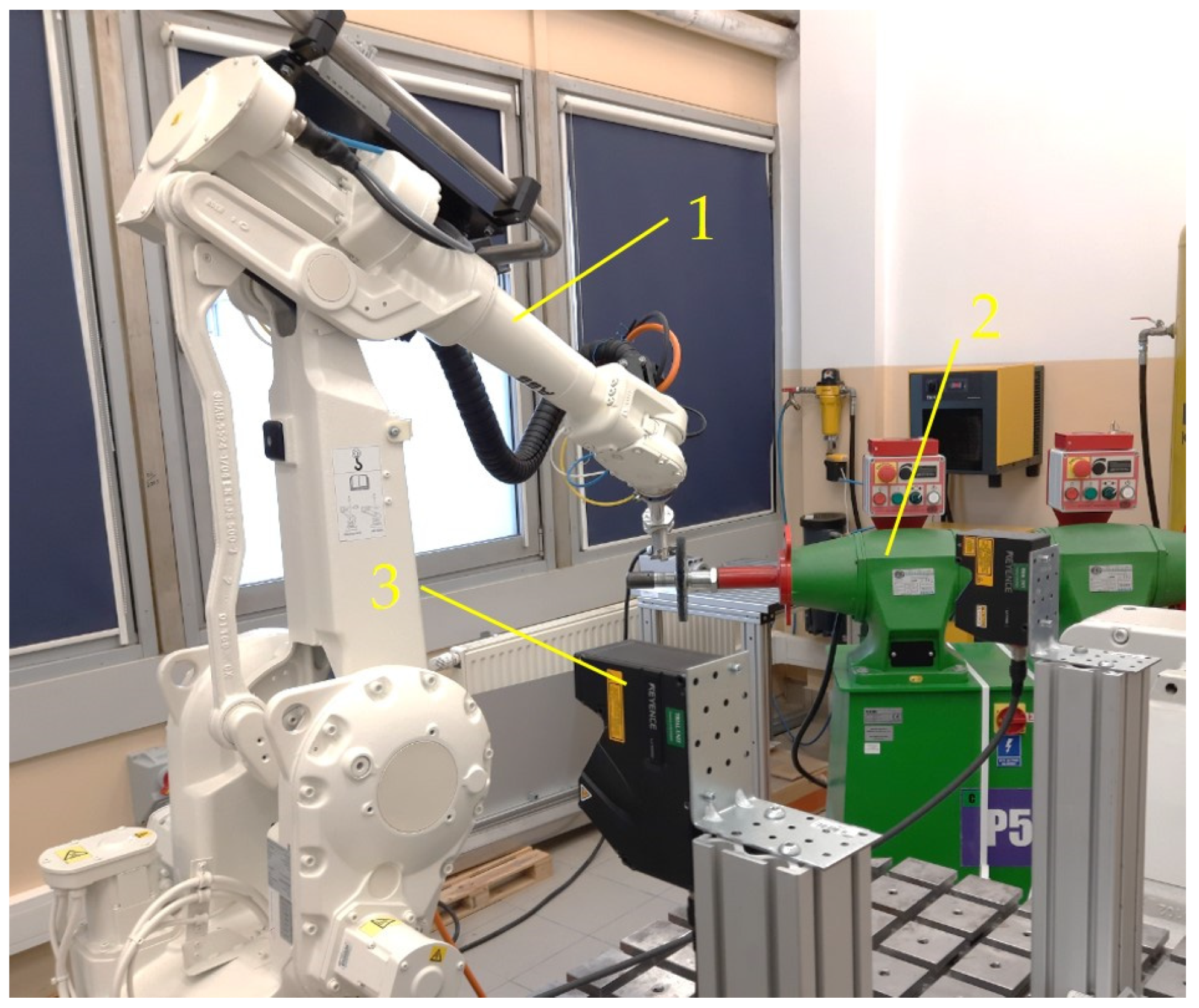

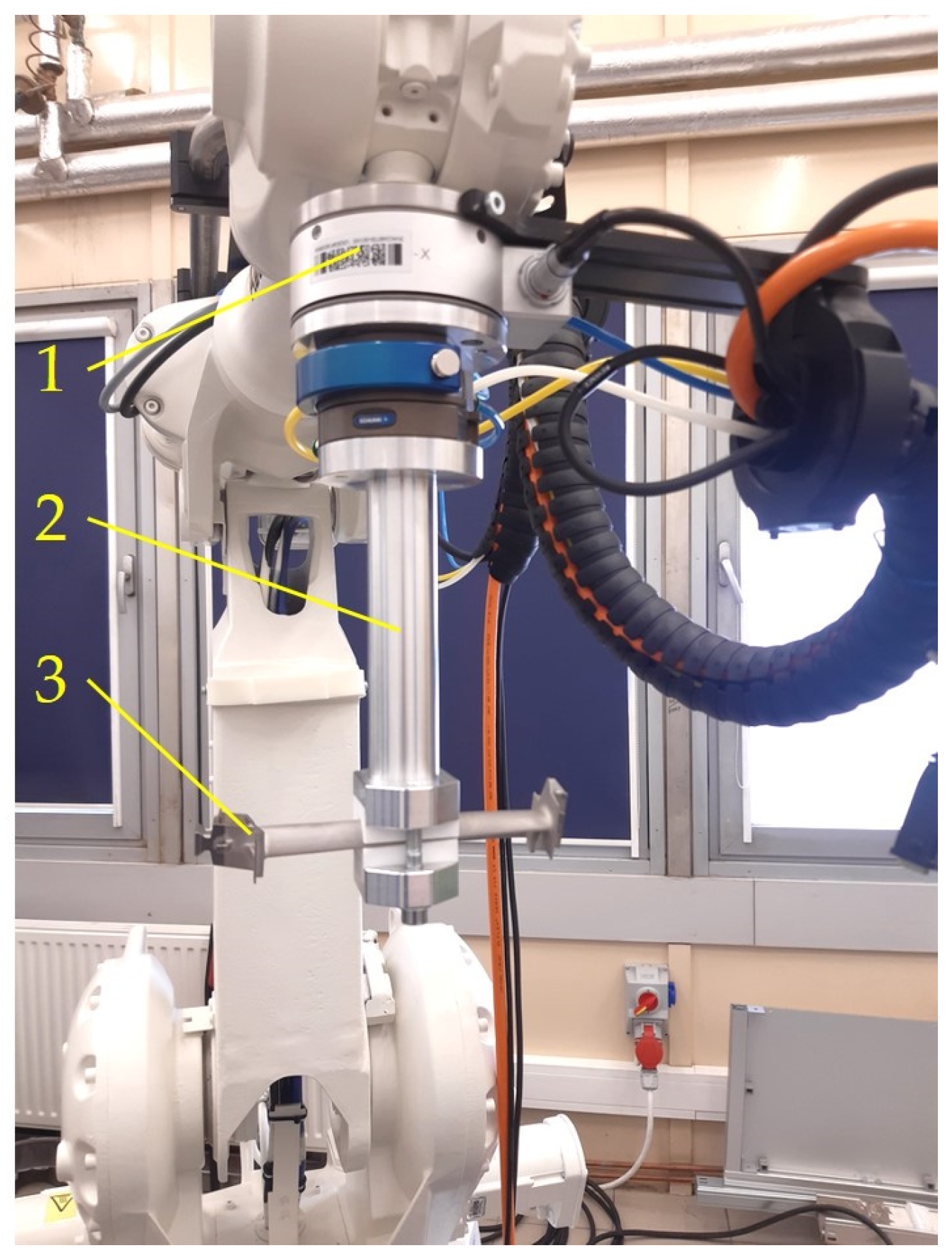
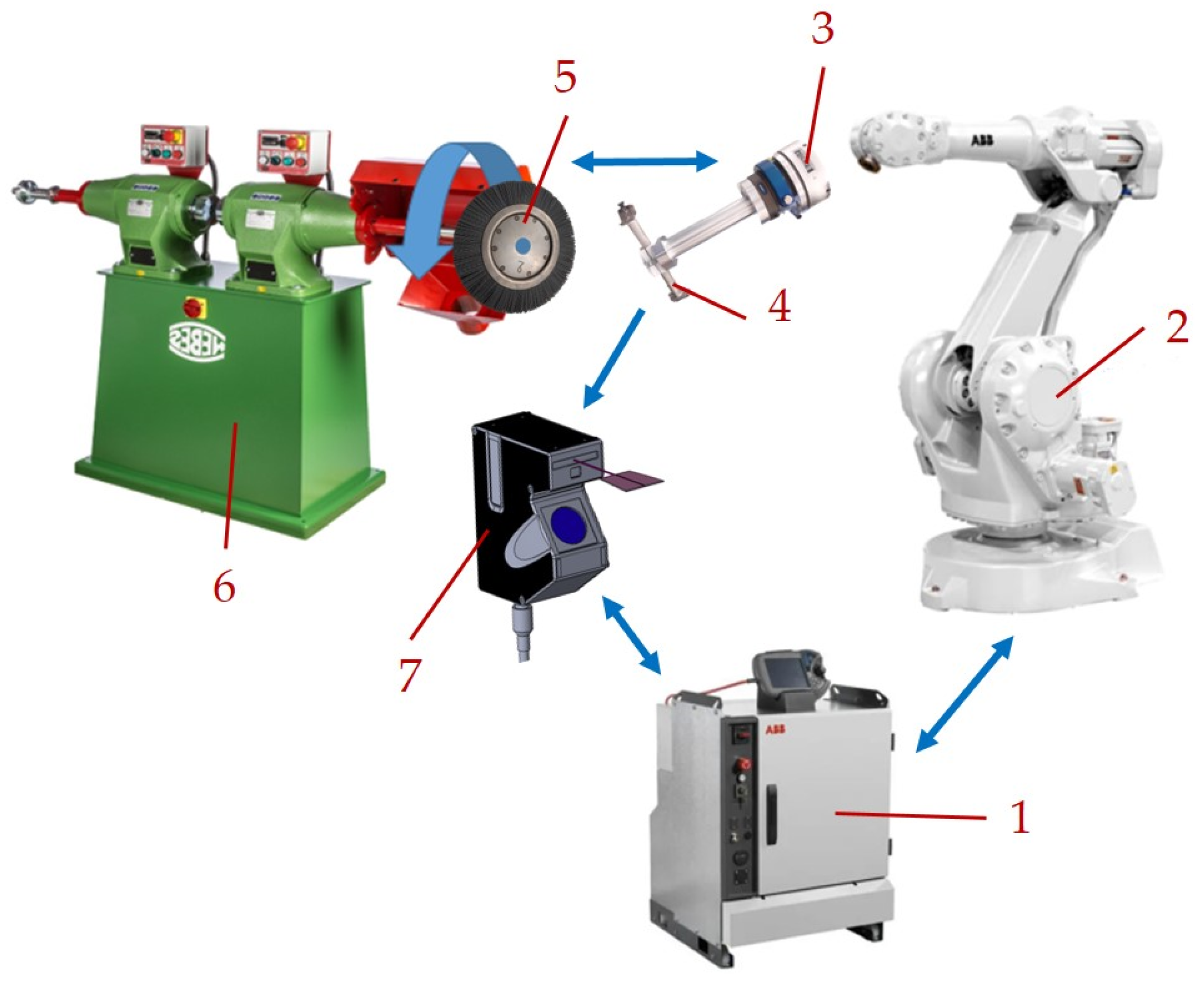

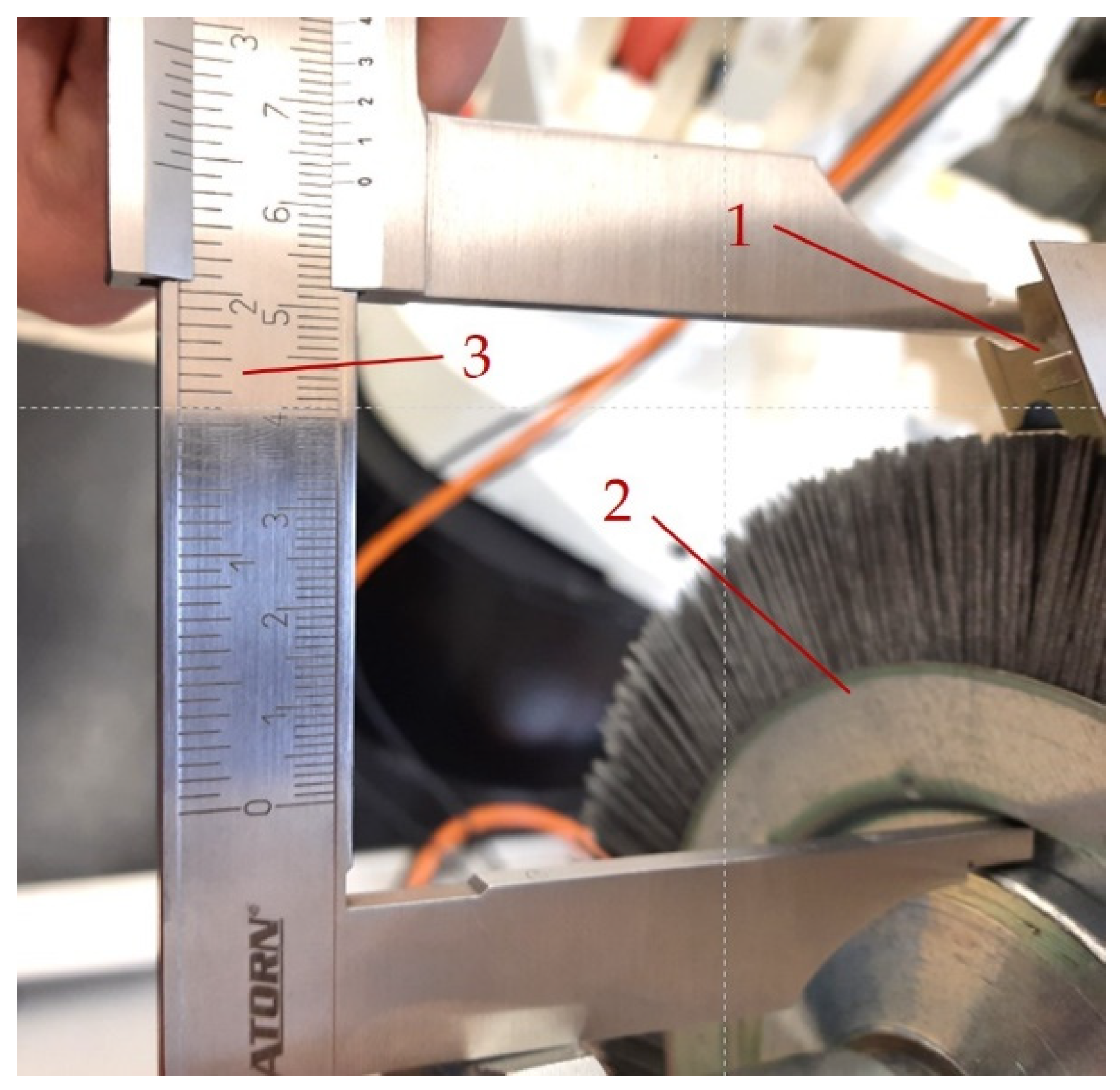
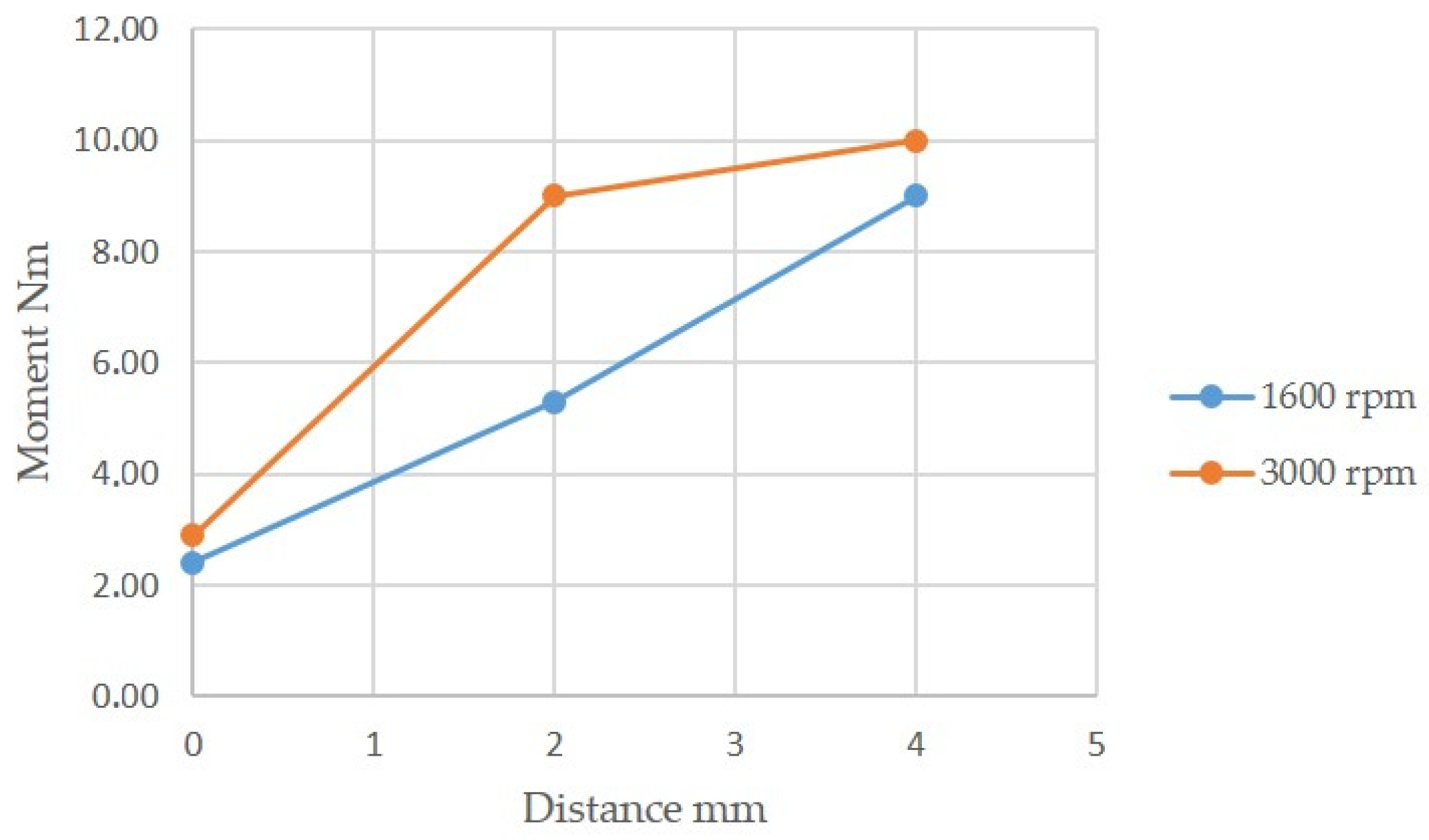
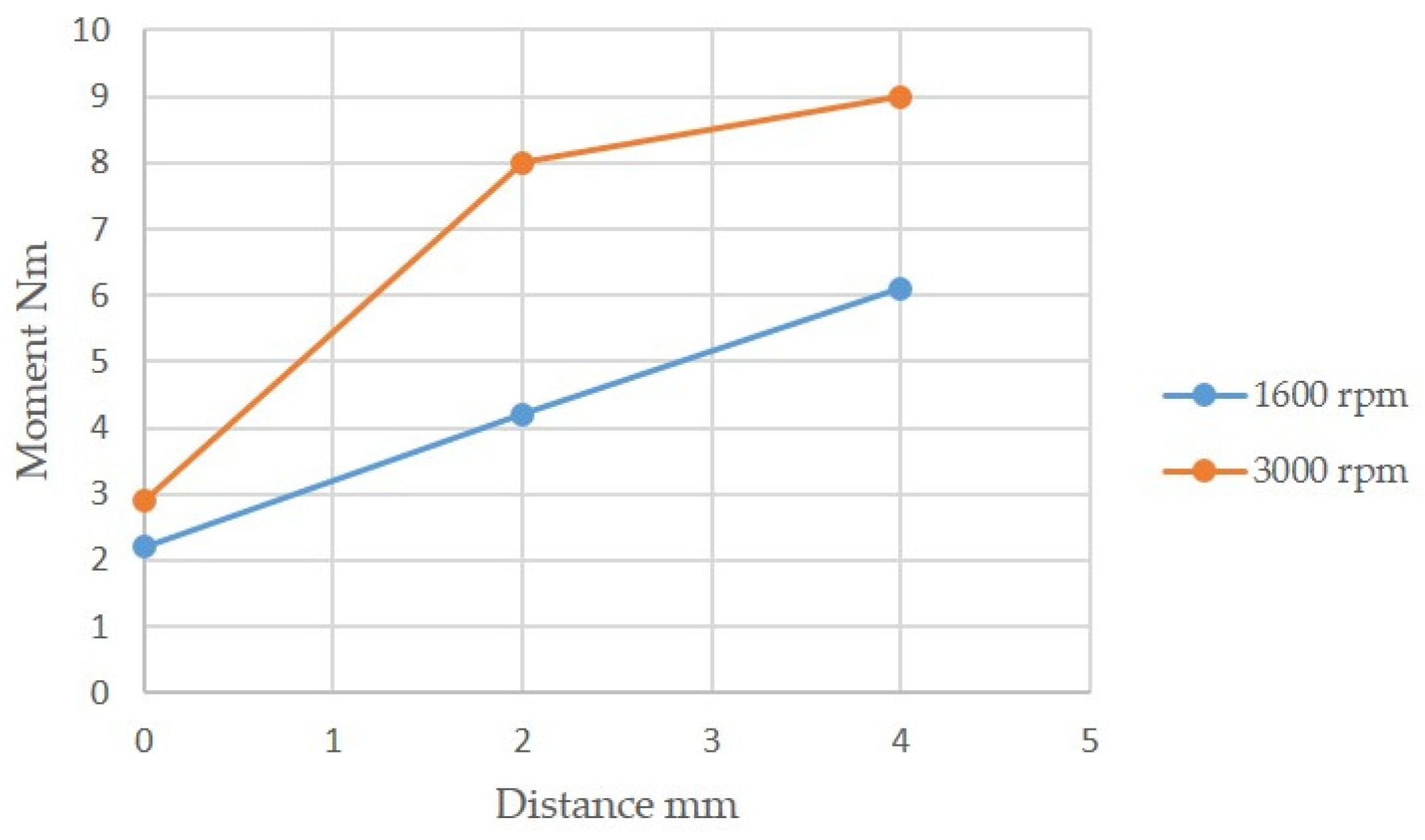
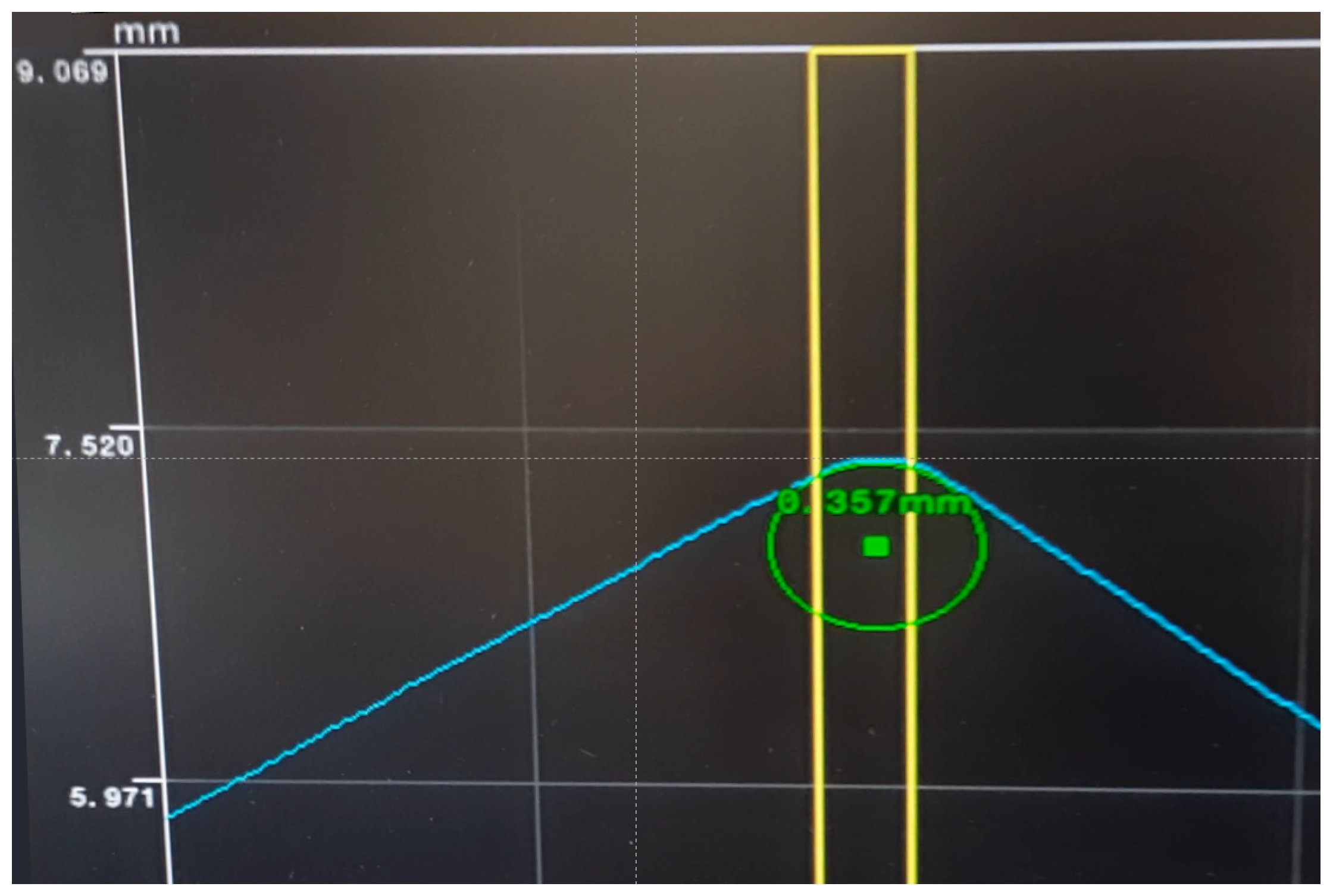



| Model | LJ-V7060 |
|---|---|
| Reference distance | 60 mm |
| Measurement range | +/−8 mm—z-axis |
| Repeatability | 0.4 µm |
| Temperature characteristic | 0.01% full scale/°C |
| Input Data | Output Data |
|---|---|
| Tool rotational speed, rpm | Radius of edge break, mm |
| Time of the operation, s | All burrs removed, yes/no |
| Depth of engage—tool and work piece, mm |
| Brush Rotational Speed, rpm | Time of Contact Work Piece—Tool, s | Force Difference, N | Moment Difference, Nm |
|---|---|---|---|
| 1600 | 5 | 30 | 5 |
| 3000 | 5 | 40 | 11.5 |
| Rotational Speed, rpm | Depth of Engagement, mm | Average Value of Moment during Deburring Process, Nm |
|---|---|---|
| 1600 | 0 (“touch”) | 2.4 |
| 3000 | 0 (“touch”) | 2.9 |
| 1600 | 2 | 5.3 |
| 3000 | 2 | 9.0 |
| 1600 | 4 | 9.0 |
| 3000 | 4 | 10.0 |
| Rotational Speed, rpm | Depth of Engagement, mm | Average Value of Moment during Deburring Process, Nm |
|---|---|---|
| 1600 | 0 (“touch”) | 2.2 |
| 3000 | 0 (“touch”) | 2.9 |
| 1600 | 2 | 4.2 |
| 3000 | 2 | 8.0 |
| 1600 | 4 | 6.1 |
| 3000 | 4 | 9.0 |
| Measurement Number | Edge Break Value, mm |
|---|---|
| 1 | 0.23 |
| 2 | 0.23 |
| 3 | 0.22 |
| 4 | 0.3 |
| 5 | 0.32 |
| 6 | 0.26 |
| 7 | 0.24 |
| 8 | 0.25 |
| 9 | 0.29 |
| 10 | 0.3 |
| 11 | 0.28 |
| 12 | 0.25 |
| 13 | 0.22 |
| 14 | 0.24 |
| 15 | 0.26 |
| 16 | 0.23 |
| 17 | 0.26 |
| 18 | 0.27 |
| 19 | 0.25 |
| 20 | 0.28 |
| 21 | 0.29 |
| 22 | 0.25 |
| 23 | 0.19 |
| 24 | 0.26 |
| 25 | 0.25 |
| 26 | 0.27 |
| 27 | 0.27 |
| 28 | 0.25 |
| 29 | 0.25 |
| 30 | 0.25 |
| Measurement Number | Edge Break Value, mm |
|---|---|
| 1 | 0.11 |
| 2 | 0.34 |
| 3 | 0.31 |
| 4 | 0.11 |
| 5 | 0.18 |
| 6 | 0.14 |
| 7 | 0.13 |
| 8 | 0.19 |
| 9 | 0.20 |
| 10 | 0.13 |
| 11 | 0.16 |
| 12 | 0.12 |
| 13 | 0.12 |
| 14 | 0.25 |
| 15 | 0.19 |
| 16 | 0.11 |
| 17 | 0.15 |
| 18 | 0.10 |
| 19 | 0.15 |
| 20 | 0.17 |
| 21 | 0.13 |
| 22 | 0.13 |
| 23 | 0.24 |
| 24 | 0.13 |
| 25 | 0.16 |
| 26 | 0.15 |
| 27 | 0.11 |
| 28 | 0.13 |
| 29 | 0.21 |
| 30 | 0.10 |
Disclaimer/Publisher’s Note: The statements, opinions and data contained in all publications are solely those of the individual author(s) and contributor(s) and not of MDPI and/or the editor(s). MDPI and/or the editor(s) disclaim responsibility for any injury to people or property resulting from any ideas, methods, instructions or products referred to in the content. |
© 2023 by the authors. Licensee MDPI, Basel, Switzerland. This article is an open access article distributed under the terms and conditions of the Creative Commons Attribution (CC BY) license (https://creativecommons.org/licenses/by/4.0/).
Share and Cite
Falandys, K.; Kurc, K.; Burghardt, A.; Szybicki, D. Automation of the Edge Deburring Process and Analysis of the Impact of Selected Parameters on Forces and Moments Induced during the Process. Appl. Sci. 2023, 13, 9646. https://doi.org/10.3390/app13179646
Falandys K, Kurc K, Burghardt A, Szybicki D. Automation of the Edge Deburring Process and Analysis of the Impact of Selected Parameters on Forces and Moments Induced during the Process. Applied Sciences. 2023; 13(17):9646. https://doi.org/10.3390/app13179646
Chicago/Turabian StyleFalandys, Karol, Krzysztof Kurc, Andrzej Burghardt, and Dariusz Szybicki. 2023. "Automation of the Edge Deburring Process and Analysis of the Impact of Selected Parameters on Forces and Moments Induced during the Process" Applied Sciences 13, no. 17: 9646. https://doi.org/10.3390/app13179646
APA StyleFalandys, K., Kurc, K., Burghardt, A., & Szybicki, D. (2023). Automation of the Edge Deburring Process and Analysis of the Impact of Selected Parameters on Forces and Moments Induced during the Process. Applied Sciences, 13(17), 9646. https://doi.org/10.3390/app13179646









